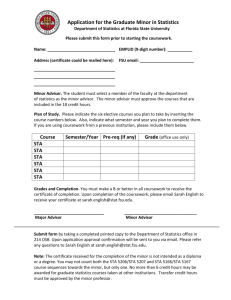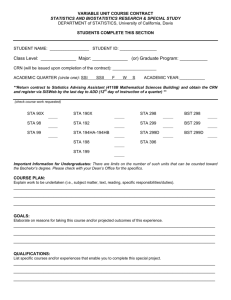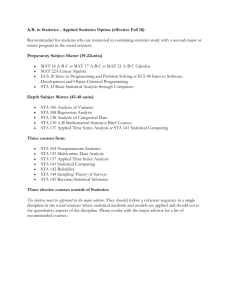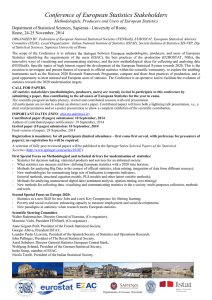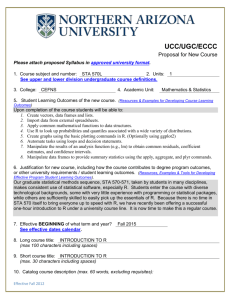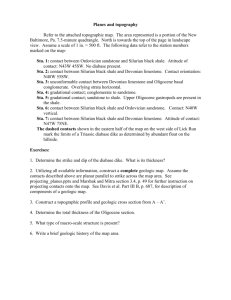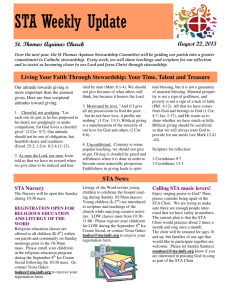STA-261-Redesign-Full-proposal--JB
advertisement
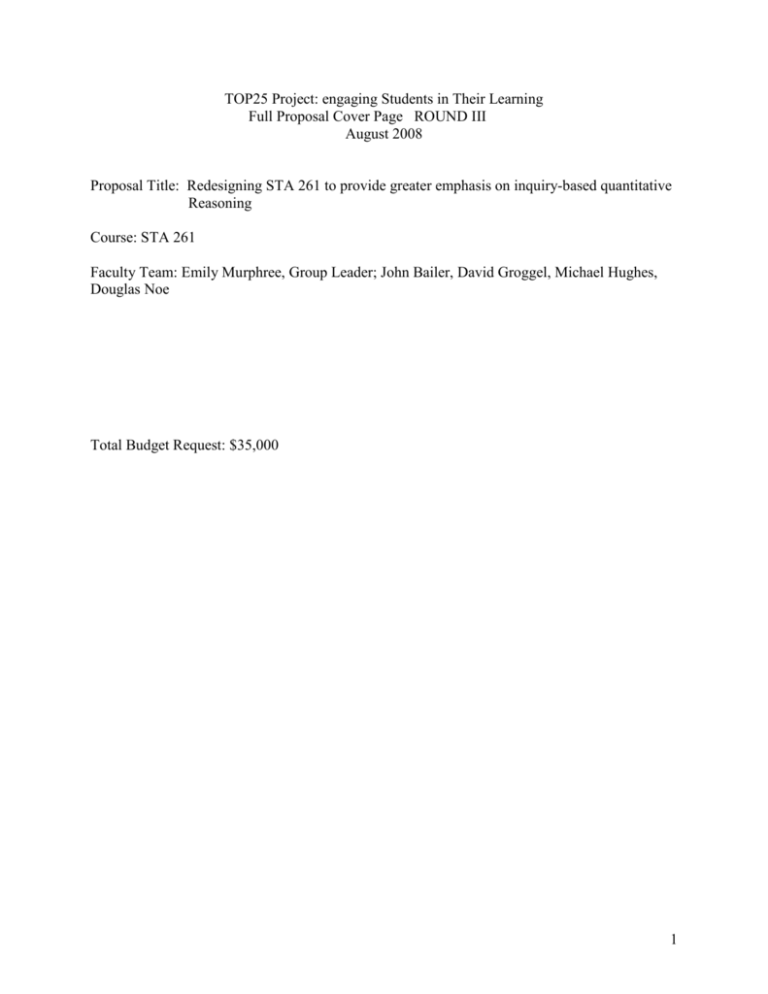
TOP25 Project: engaging Students in Their Learning Full Proposal Cover Page ROUND III August 2008 Proposal Title: Redesigning STA 261 to provide greater emphasis on inquiry-based quantitative Reasoning Course: STA 261 Faculty Team: Emily Murphree, Group Leader; John Bailer, David Groggel, Michael Hughes, Douglas Noe Total Budget Request: $35,000 1 1. Abstract The new STA 261 will maintain the intellectual content of the current version but will be reorganized to meet three times each week in large lecture sections taught by seasoned teachers and twice each week in small lab groups directed by graduate assistants. In lab, students will flesh out ideas discussed during the lectures by working through a prescribed collection of exercises designed to be "concept probes." The exercises will emphasize inquiry-based learning where students can explore appropriate ways of displaying and interpreting data. Students will create portfolios over the course of the semester in which they collect and comment on articles and data sets illustrating the key learning objectives for the course. To ensure that students practice routine calculations and learn the basics outside of class, we will employ one of the many online homework systems that come packaged with introductory textbooks. We anticipate that this will result in deeper learning of statistical concepts. In addition, we believe that students will have a more positive attitude towards using numerical data to support decisions or positions, and will have more confidence in dealing with the flood of numerical information they encounter in everyday life. 2. Detailed and Expanded Description of Redesigned Course The current version of STA 261 is taught in multiple, independently run sections. Some are taught by experienced faculty members in sections of 55—60 students while others are taught by instructors or graduate assistants in sections of 30—40. We believe our proposed arrangement of large lectures supplemented by small group lab experiences will make students’ experiences and assessment much more consistent than they have been. We will take advantage of multiple resources developed by other academic institutions and professional statistical societies to encourage activity-based learning in introductory statistics. The AIMS (Adapting and Implementing Innovative Material in Statistics) Project, an NSF-funded undertaking at the University of Minnesota, is just one example of the resources we will tap. The Consortium for Advancement of Undergraduate Statistics Education (CAUSE) website developed by Ohio State University is another. Both the AIMS website (http://www.tc.umn.edu/~aims/) and CAUSE (http://www.causeweb.org/resources/) post open-source data sets, suggested class activities and teaching tools. Their materials are aligned with the active-learner model endorsed by the American Statistical Association’s Guidelines for Assessment and Instruction in Statistics Education (GAISE) for teaching introductory statistics (http://www.amstat.org/education/gaise/). The AIMS site states their “lessons, which build on implications from educational research, involve students in small and large group discussion, computer explorations, and hands-on activities.” For example, the “plans suggest how teachers may guide students through activities where they are actively engaged in making and testing conjectures, working in small groups, explaining their reasoning, and learning together. The materials also incorporate versions of many innovative student activities.” Previously developed materials like these as well as materials we develop ourselves during the summer months of 2009 will be used in both the lecture and lab classes. The large lecture classes will serve groups of 100—150 students. Lecture will emphasize the importance of using statistics to make decisions when faced with uncertainty. We want our students to learn that carefully designed experiments tell us much more about the world than 2 anecdotes or hunches. We will use the large group lectures to present key ideas about displaying and summarizing data, variability, probability, random sampling, and how to draw inferences about unknown population characteristics from known sample data. We will guide students as they grapple with open-ended questions and learn to reformulate the questions in suitable statistical language. Once students have translated their practical questions into statistical parlance, they can learn to choose appropriate procedures to address the question at hand. We will also illustrate using statistical software and interpreting its output in class. We will emphasize that there are often multiple ways of addressing the same question. For example, the central tendency of a data set can be measured by the mean, median, mode, or trimmed means. Lecture time can include time spent in guided inquiry tasks such as “if you are moving into a new community and considering the cost of housing, then what summary of house prices would you prefer and why?” Although many students are shy about speaking up in large groups, we can use clicker technology to encourage involvement by all students. For example, we could ask students to choose a number between 1 and 10, capture their responses, and then examine graphs of their choices. This could lead to a discussion of random samples and whether the numbers selected are an example of a random sample. Additionally, we could begin class by reading about a specific study reported in the national media and ask students to register whether they believe the study was statistically sound and the conclusions were justified. After student responses are tabulated, we could encourage the students to explain their votes. All of us who have taught STA261 know that most students can follow all the steps as an instructor works his/her way through a problem from set-up to final conclusion. The instructor’s choice to fit a regression line, perform a t test, or compute a large sample confidence interval may seem obvious at the time. Students may be lulled into a false sense of security as they serve an “apprenticeship” watching a master because it is much more difficult to do all the steps on one’s own. We have always used homework and quizzes to help students become active participants in statistical analysis, but now we will expand these with the proposed lab sections and online homework exercises. All students will be required to show competence on computer-based exercises linked to the topics covered each week in class. For example, when we cover the normal distribution, we will require students to show that they have mastered using normal tables (or using software that calculates the quantiles or tail-areas/probabilities reported in such tables) and computing Zstatistics before they explore lab activities using the normal distribution. A portion of students’ course grades will depend on their timely completion of the on-line assignments. The lab sections will allow the students to build on the material from lecture and the online work. We intend to develop (or adopt from AIMS, CAUSE, or other sites) 10—15 lab exercises the students will use to probe key ideas. Good students should be able to work through the exercises alone or with a partner. Graduate students can prompt the weaker students and help the students put their discoveries in context. As examples of potential concept probes, consider: we could give students data showing the age and muscle mass of women between 40 and 80 years old. The students would use software to graph the data and decide if there is an 3 approximate linear association between the two variables. They could guess at the equation of the line best representing the data and then compare their line to the least squares line fitted by the software. They could evaluate how much better that line fits than their guessed line did. They can also explore what happens to the equation of the line as more data are added (JAVA applets or other web resources might be ideal for this type of exploration). In particular, we could ask them whether the line changes more dramatically when we add a point representing an unusually fit 78 year old or another representing a weakling 60 year old. Finally, we would ask them how their observation about these outliers meshes with what they learned in lecture about regression lines. We could ask students to use computer simulations to explore how well sample characteristics estimate population characteristics. For example, we can have students simulate choosing a sample of voters from a population where p% support candidate X. The students can check how well their sample poll numbers allow them to estimate p. We can ask them to explore the impact of sample size on their estimates. The graduate assistants will be extensively trained in leading labs and will be required to attend all the lectures so they will be aware of any particular issues arising in lecture class. If the professor teaching the lecture is aware that students are having particular problems with some concept, the assistants will be alerted and the lab work adjusted. There may be lab days when much or all of the time is spent reviewing troublesome problems before the class is ready to advance to the next concept probe. Students will have the opportunity to build on and integrate their in-class experiences by developing portfolios throughout the semester. We will ask the students to collect a certain number of examples (to be determined) from news media, other classes, or their personal reading showing: Examples of faulty statistical reasoning. Examples in literature where probability and/or statistics plays a crucial role. Studies showing proper attention to randomization of treatments, random sampling, blinding, care in drawing conclusions. Studies showing improper extrapolation of results. Articles where association is confused with causation. Specific examples of surveys using leading questions. Surveys suffering from serious nonresponse bias. Good and bad graphical depictions of data. Studies where proper concern is shown about respondents giving dishonest answers in order to save face. Colorful examples of “innumeracy” in our common speech —“giving 110%;” “where everyone is above average;” “the third half of the show.” Interesting data sets relevant to their major. 4 Statistical results that are surprising: mean body temperature isn’t 98.6° ; the probability of a boy is not 50%,… Interesting statistics from history: what percentage of WWII recruits were undernourished; when was the first female or African American student enrolled at college X; what was the population of a student’s hometown in 1900; how was the US Census conducted in 1800;… Examples of good statistical writing in the media. For each example students collect, they will be asked to write a short explanation justifying its inclusion as an example of a particular category above. As part of the development work to be done, we will formalize the requirements of this project and develop a rubric for evaluating it. 3. Characteristics (1—4) of New Learning Models 1. Student-centered, active-learning and inquiry-based approaches As outlined in section 2, these approaches are built into the AIMS and CAUSE materials we will be adopting for use in both the large lecture and small group lab sections of STA 261. Statistics is by its nature an inquiry-based activity in which questions are posed and answered based on quantitative evidence found in datasets. In addition to the hands-on data analysis the students will do for homework and in lab, students will be actively engaged in creating their portfolios. In finding articles for the portfolios, students will see how issues discussed in class like sample selection, survey design, and data interpretation can either doom or bolster a real-world study. 2. Methods to engage students in their learning and with other learners Again, the GAISE and AIMS materials are designed to include small group activities. Both lecture and lab classes have engaged student learning at their hearts as does the portfolio project. Class discussions will require students to articulate what they see in datasets and muster quantitative evidence supporting their point of view. Students will engage with each other and with their instructors as they defend their various positions. As examples, we can ask students whether they see systematic patterns in the draft numbers assigned to potential conscripts in 1970 that imply the US draft lottery did not assign numbers at random to birthdates. Problems can be posed in class and assigned to small groups for presentation the next class meeting. Some of the lab activities will involve students working together on projects. 3. Approaches that result in improved student critical thinking or problem-solving Statistics is all about problem-solving and critical thinking. It is where mathematics, uncertainty, and the real world intersect. Not only must students be absolutely clear and logical in setting up and solving statistical problems, they must be aware of important issues like clearly distinguishing a premise from a conclusion; evaluating the strength of their evidence by calculating probabilities like p-values; and being conscious of the possibility that 5 the incomplete information in sample data can mislead us. Students will spend more time on interpreting data than they will on calculating means, standard deviations, and test statistics. (That is the beauty of statistical software.) We will use statistical software that removes the computational busy-work of certain summary calculations, and allows for exploration of more complex data sets. The selection of the software will be one of the tasks to be addressed by the summer 2009 working group. 4. Strategies that reduce the amount of class time spent on low-level memory or descriptive material The aforementioned on-line homework system for practicing routine problems and the extensive use of statistical software for data analysis will allow us to use class time for important topics. Students will also use software in labs and in their out-of-class homework assignments. 4. Increase in time students spend preparing for class STA 261 is a four credit course. In its current form, the class meets for four 50 minutes sessions per week. The new format envisions maintaining the four credit status but requiring five contact hours (three 50 minute lectures and two 50 minute labs) plus time outside class spent reading the textbook, working on-line problems, and working problems assigned from the textbook. Given our experience in teaching STA 261, we are confident that students will spend at least if not substantially more than twelve hours per week mastering the concepts of STA 261. Our students often tell us how many hours they spend working on their homework alone, much less reviewing their notes, poring over sample computer outputs, and so forth. 5. Evidence We will be implementing “best practices” materials developed in accordance with guidelines and recommendations from professional societies. The American Statistical Association (ASA) funded Guidelines for Assessment and Instruction in Statistics Education (GAISE) Project recommends (from http://www.amstat.org/Education/gaise/GAISECollege.htm): i. ii. iii. iv. v. vi. Emphasize statistical literacy and develop statistical thinking; Use real data; Stress conceptual understanding rather than mere knowledge of procedures; Foster active learning in the classroom; Use technology for developing conceptual understanding and analyzing data; Use assessments to improve and evaluate student learning. All the material we will adopt from CAUSE and AIMS will have these characteristics as will the in-house activities we develop. We believe student satisfaction with their learning will increase because lectures will be given only by experienced full-time faculty members who have proven records of effective teaching at 6 the introductory level. Also, the course is structured so that there is minimal lag-time between the presentation of a statistical concept in lecture and student practice and exploration of that concept in the lab groups. Students should enjoy interacting with graduate students in the lab setting and may be more likely to ask questions in the inviting atmosphere of small group sessions. Additionally, the lab activities should help students pinpoint where their weaknesses lie and help them formulate questions. (We sometimes hear from students that they don’t ask questions because they don’t even know where to start.) Our conversations with members of Miami’s Information Technology staff indicate that the clicker technology does encourage participation of even the shyest student in a class of 150. Colleagues report that students are enthusiastic about the immediate feedback they receive from on-line computer homework systems. In addition, weaker students like the opportunity to do extra problems until they have built up their skills and confidence. 6. Efficient Use of Resources We believe the proposed redesign will accomplish several goals. First, the lead instructor for STA 261 will be a full-time faculty member. This is in concert with the university’s goal for its high enrollment undergraduate courses. It is certainly an efficient use of university resources to use faculty members with proven records of good teaching in this high-profile role. Graduate students gain important teaching skills from learning how to conduct a class and explaining concepts to beginning students. However, in the new design, the graduate students will not be responsible for the pace or content of Sta 261. They will use the teaching materials developed by faculty and will not be responsible for writing tests or computing course grades. These latter tasks are generally best left to faculty. The graduate assistants will help grade tests and, like the lead instructor, will hold office hours and review sessions. We believe this is an appropriate use of graduate students’ time and expertise. Once the redesigned STA 261 is fully implemented, we anticipate that the number of sections will decrease from our current 12—15 sections per semester accommodating approximately 600 students to 4—5 sections of STA 261accomodating the same number of students in large lectures of 125—150 students with break-out small lab groups of 20—25 students each. We propose running a pilot version of the new STA 261 in the Fall semester of 2009 in just one large lecture section with accompanying labs. All other sections would be taught according to the usual model. We want to assess our proposed redesign before a full implementation is launched. 7. Cost per student equal or less than current levels In the current Spring 2009 semester, STA 261 is being taught by three faculty members, three instructors, and three graduate students. This is a fairly typical mix of teaching staff for the course in its current form. By moving to the redesigned course, we will be using no more faculty resources. We will not use any instructors for STA 261 but will increase the number of graduate students from the current 3 to perhaps 10. Moving to 10 or so is feasible because we will have an independent Statistics Department beginning in July, 2009 and that department will have its own graduate students. Currently, many students studying for master’s degrees in statistics and holding assistantships in the Department of Mathematics and Statistics teach pre-calculus rather than STA 261. With a new department dedicated to Statistics, we can assign our assistants to 7 261, particularly because we will not be asking them to teach on their own. Graduate students assisting in STA 261 will be responsible for 2 or 3 different lab sections per week (each meeting twice). We believe this model will not increase costs. (We are not accountants; how one prices a graduate assistant’s cost depends on one’s budget model.) 8. Assessment Plan The major student learning outcomes for STA 261 are for students to understand why: Data beat anecdotes. Variability is natural and is also predictable and quantifiable. Random sampling allows results of surveys and experiments to be extended to the population from which the sample was taken. Association is not causation. Students should be able to recognize: Common sources of bias in surveys and experiments. How to determine when a cause and effect inference can be drawn from an association, based on how the data were collected (e.g., the design of the study) Students should understand the parts of the process through which statistics works to answer questions, namely: How to obtain or generate data. How to graph the data as a first step in analyzing data, and how to know when that’s enough to answer the question of interest. How to interpret numerical summaries and graphical displays of data – both to answer questions and to check conditions (in order to use statistical procedures correctly). How to make appropriate use of statistical inference. How to communicate the results of a statistical analysis. The redesigned course will assess content mastery, critical thinking, and student satisfaction by: i) Developing a rubric for grading the student portfolios. The rubric will assess whether the materials each student collects and the student’s commentary on those materials shows the achievement we desire. 8 ii) Developing exams whose questions are clearly tied to the learning outcomes outlined above and whose scores can help us assess students’ strengths and weaknesses. Tying the lab concept probes to lecture material and learning outcomes. iii) We anticipate using the Assessment Resources Tools for Improving Statistical Thinking (ARTIST at https://app.gen.umn.edu/artist/). These tools were devised “to help teachers assess statistical literacy, statistical reasoning, and statistical thinking in first courses of statistics. This web site provides a variety of assessment resources for teaching first courses in Statistics.” In addition, we are working with Andrea Bakker in the Office of Liberal Education on assessing student attitudes before and after taking STA 261. 9. Expected time line… Summer 2009 Fall 2009/Spring 2010 Summer 2010 Fall 2010 Develop course materials (labs, concept probes, GA training materials) Pilot test the redesigned STA 261 class with special sections each semester Assess the redesigned STA 261. Compare to the traditional sections offered the previous year. Revise the class based on this assessment. Fully implement the redesigned class. 10. Certification 11. Budget Personnel Summer 2009 Salary Salary Salary Benefits (35%) $5000 $5000 $5000 $5250 Activity Develop course materials (labs, concept probes, GA training materials) Murphree Groggel Noe Summer 2010 Assess the redesigned STA 261. Compare to the traditional sections offered the previous year. Revise the class based on this assessment. Salary $5000 Salary $5000 Benefits $3500 (35%) Other $1250 TOTAL $35000 TBD TBD Support consultant visit (e.g. Dennis Pearl or Jackie Miller, OSU) or purchase server license for StatCrunch or other software 9 10 From Mike: I don’t think we need the detail on software in the proposal. We can discuss this broadly and then hash this out in the summer. Other options we can consider include StatCrunch developed by Webster West. Check out http://www.stat.tamu.edu/~west/ http://www.statcrunch.com/ I have looked into several options for software for a retooled STA261. I am thinking of a twopronged approach: 1. In-class demo software for concept illustration/reinforcement 2. Software for basic data analysis 1. I‘ve checked into a few (disparate) sources for demos and applets for in-class, but the best single source by far is Gary McClelland’s Seeing Statistics (http://www.seeingstatistics.com/). This is a great resource for illustrating many statistical concepts via interactive demos … they cover pretty much everything we’d usually touch on in STA261. Advantages: Web-based so it’s universally available Comprehensive Instant access to an online calculator, glossary and equation resource via menus Ease of use Ties to Minitab, Excel, JMP and Statview integration Direct links to application illustrations in specific disciplines Disadvantages: Uses Java-based applets that are said to be unreliable on Mac OS (no problem with Windows) … no personal experience to support this, though Probability coverage is pretty limited (but don’t know if any curriculum changes will make this moot) There is a supporting book (not really a text, more of an outline of the software) … but it may not really be necessary as the web-based software is freely available and easy to use 11 Coordination with Weiss or other textbook? 2. I am of the opinion that students should have ready access to their own personal copy of a legitimate stat software package … not some rudimentary web-based “stat calculator” or something that is otherwise not really used in the “real world”. Even at this starting level, I think thy should get a feel for how to work with real software. Yes, 261 will be a terminal course for many, but I also think it is a disservice to those who may go on to minor or take a thematic sequence or whatever to NOT expose them to it. We had considered JMP recently, but it appears that IT has since pulled support for it. So in my mind, the real options are: Minitab. o Advantages: We all know it; covers everything we need to cover; facilitates some basic simulation stuff (though this requires abandoning context, as strongly recommended by the GAISE report); easy interface. o Disadvantages: Windows only (deal-breaker, I think); students must now pay a fee for use; time-bombs after 6 or 12 months. Excel. o Advantages: Everyone will already have it (Mac or PC); basic stat procedures available through add-ons; very quick learning curve; simulations possible but requires programming skills o Disadvantages: Will require most of us to rethink how we do basic stats using software (except Bob Noble!); might need Bob N to provide us with a tutorial R (specifically, R-Commander). o Advantages: Menu-driven interface; free and you have it forever; works on all operating systems; expandability for those who want to move on past 261 o Disadvantages: not the sexiest software out there; probably a longer learning curve for some; may require some training of faculty for usage by those who have used it This will require a lot of discussion on our part. I personally would rank the choices as follows: I am reluctant to opt for Excel as a stat software package. I would prefer a stat specific tool. 1. Excel 2. R-cmdr 3. Minitab Excel has the least risk involved as far as software “getting in the way” of learning the material, IMO, and at no added cost to the student. R-commander might be used as a supplementary package by more “motivated” students or by those who wish to move on beyond 261. (I should say that in my 363 class last semester, I used R (programming script interface, no menus) and had NO complaints …. In fact, several students surprisingly told me they REALLY liked it). Check out the recent NY Times piece on R … 12 http://www.nytimes.com/2009/01/07/technology/business-computing/07program.html?_r=1 The only other issue I feel (and would really like to see) is a reliable electronic mechanism for instant student feedback in the classroom. This would be for the purpose of instant polling and/or data collection for instant analysis. It appears as though TurningPoint (http://www.units.muohio.edu/mcs/suppctr/techtalk/archives/2008Apr/Articles/TurningPoint.htm) is the ticket here, but how it would integrate with a chosen software package for “instant analysis” is as of yet unknown (this is important, I think). I’m confident that were it to integrate with ANYTHING considered above, that Excel would likely be the most cooperative choice. 13
